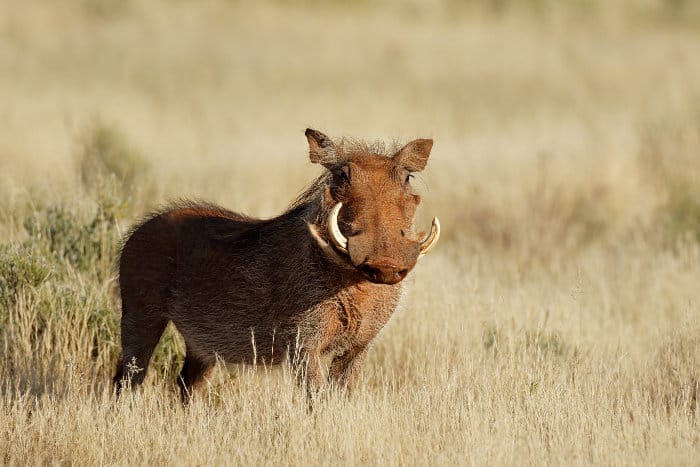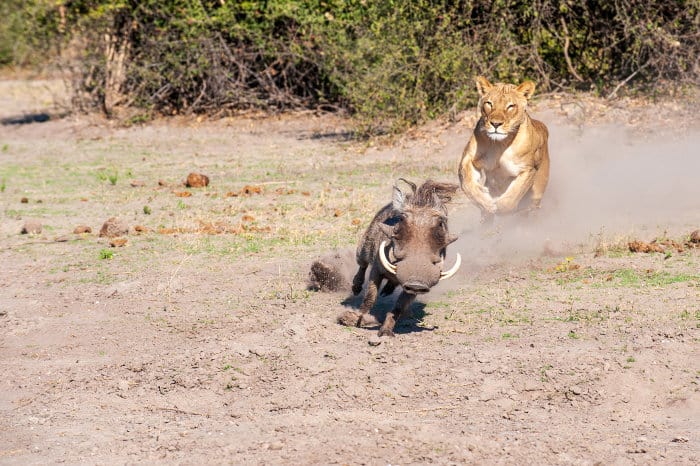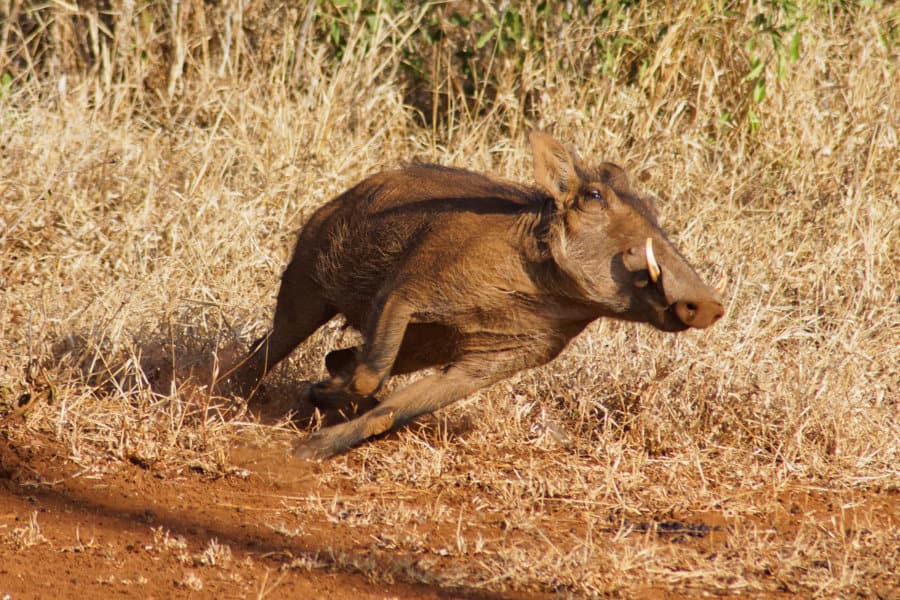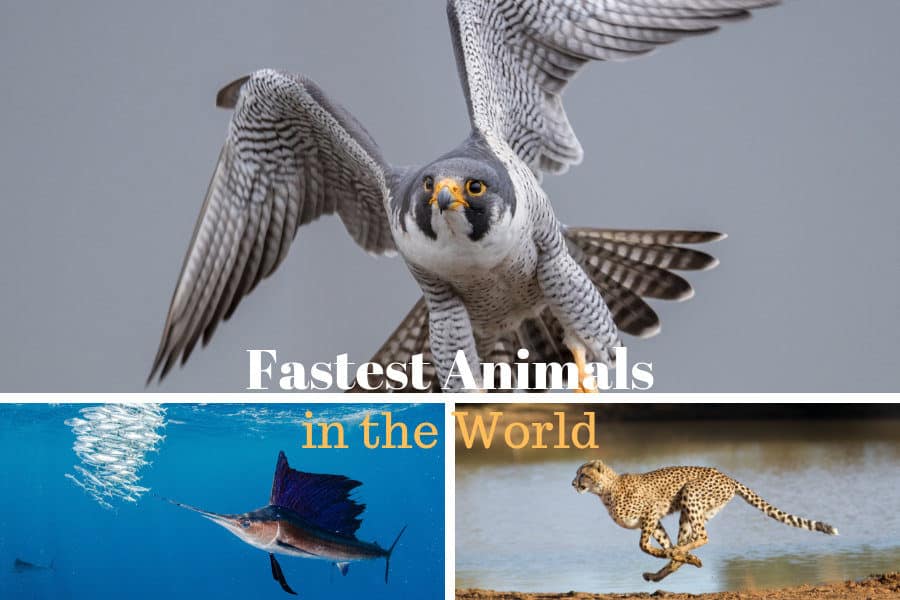Warthogs might not top the list of the fastest animals in Africa, but they can still run at up to 55 km/h. These small land animals can easily outrun Usain Bolt!
Most of us enjoyed the movie The Lion King, where you would have met the world’s most famous warthog – Pumbaa. Well, it turns out that Pumbaa can run really fast. These unique creatures have had to adapt to their harsh environment where lions, wild dogs, leopards, and many other predators could be lurking behind the next bush.
Poor warthogs often get forgotten or ignored when out on safari. We feel these animals deserve more attention thanks to their speed, acceleration, and unique behaviors.
Types of Warthogs

Before getting into the facts about warthogs’ speed, we first have to look at the two types of warthogs. The common warthog (Phacochoerus africanus) and the desert warthog (Phacochoerus aethiopicus) are two distinct species of warthogs.
Although they were originally both classified as Phacochoerus aethiopicus, scientists reclassified the common warthog. These animals look very similar, but the desert warthog’s adaptations are their size and lack of incisors.
When we refer to these mammals, we are generally speaking about the common warthog. These are the most abundant species and live throughout the African savannahs. However, you will only find the desert warthog in the horn of Africa.
How Fast is a Warthog?
The desert warthog is the faster of the two species, reaching up to 55 km/h (34 mph). Common warthogs, on the other hand, average around 48 km/h (30 mph) – which is still really fast. This difference is largely attested to the desert warthogs’ lighter weight.
Both of these animals are members of the Suidae (pig) family and have earned warthogs the title of ‘fastest pigs in the world’.
Despite their size and stature, these warthogs are very quick. The first time you see a warthog take off is always a wonderful surprise. Not only do they go from zero to 55 km/h in a flash, but warthogs’ tails immediately shoot towards the sky.
One second they will be walking around, searching for their favorite warthog food, and the next second they will be disappearing from your vision. These alert animals are always on the lookout for predators, ready to sprint away at a moment’s notice.
Are warthog babies fast?
Warthog babies are some of the cutest things you’ll see. Called piglets, they are born after a 5 to 6 month gestation period. These adorable animals are still very small at birth and require 20 months before they are fully grown.
Although they gain mobility fairly quickly, they have a long way to go before they are as fast as their parents. During this time, piglets are at their most vulnerable and prone to predation from a variety of animals – including eagles.
Warthog Speed vs Predators

Compared to the predators that warthogs are up against, they aren’t that fast. Lions, wild dogs, hyenas, leopards, and cheetahs can all outrun a warthog.
They are also significantly slower than the other prey species, like springbok, wildebeest, and other African antelope. So how do they survive?
Warthog survival tactics
Warthogs owe their lives to their incredible acceleration as well as their stamina. If you watch a warthog take off, it’s similar to a Ferrari. If you blink too slowly, you’ll miss it.
As soon as a predator startles a warthog, it will start running. These timid creatures will much rather run than face their attackers head-on, although they will charge if cornered.
When the opportunity presents itself, the warthog will choose to go running into its den or dense vegetation. If the warthog arrives at the den, it will reverse inside, rear first. This gives it a better chance of protecting itself in the enclosed space with its sharp tusks sticking out.
Warthogs are clever; in the morning, they are often seen darting out of their dens. This is to catch any lurking predators off-guard. These animals know they are fast, and they utilize this to their advantage.
Warthogs vs lions, leopards, and cheetahs
Lions, leopards, and cheetahs are some of the main predators of warthogs and are much faster. Despite the considerable difference in speed, these carnivores can only maintain it for short bursts.
Warthogs have much better stamina than fast lions, leopards, and cheetahs. If they are able to reach their top speed quick enough and evade the initial burst of their predators, they will be able to live another day.
Warthogs vs wild dogs and hyenas
Although most of us grow up fearing lions, leopards, or cheetahs, wild dogs and hyenas are far scarier. Wild dogs and hyenas’ speeds are not only faster, but they have excellent stamina and hunt in numbers.
If either of these animals set their eyes on a lonely warthog, there is very little these African pigs can do to stop their onslaught. An isolated warthog’s best bet will be finding other animals or defending itself as best it can (their tusks are pretty fierce).
The Fastest Pigs in the World

The common and desert warthogs are two incredible animals. They have managed to survive in the plains of Africa for thousands of years thanks to their dexterity, acceleration, and stamina.
These brave animals go up against some heavy odds. Every day they come face to face with some of the biggest, meanest, and fastest animals in the world. Despite this, they never let their fear get the better of them and are ready to hit the gas in an instant.
Although they might not be as glamorous as some of the many other African animals you will see on safari, they are such spectacular creatures to observe.
Not only are they very interesting, but watching this species is always a great way to see some exciting animal encounters. Book a safari now, and you might be lucky enough to see a warthog darting away from a nearby lion. Who will win the race this time?



